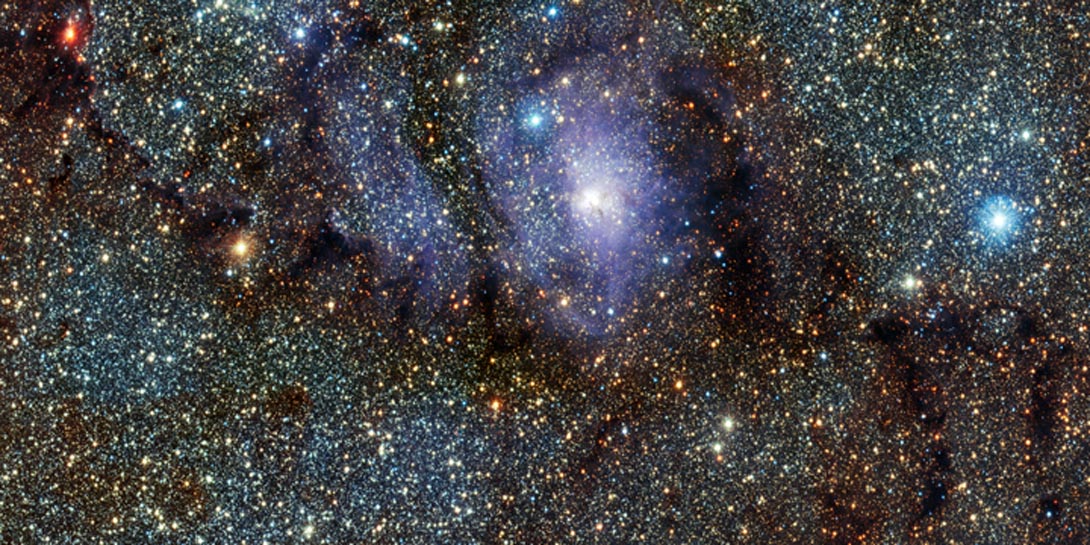
Star Formation Nebula
RA 18h 3m 42.09s Dec -24° 25' 7.43"
Sagittarius
5000 light years
34.03 x 15.11 arcminutes
North is 29.3° right of vertical
ESO/Ack: Cambridge Astronomical Survey Unit
January 5, 2011
Wide: 1403c 0936 1101w 1101a 1403 Closeup: 1517 1015 1120 1808
ABOUT THIS IMAGE:
This new infrared image of the Lagoon Nebula was captured as part of a five-year study of the Milky Way using ESO's VISTA telescope at the Paranal Observatory in Chile. This is a small piece of a much larger image of the region surrounding the nebula, which is, in turn, only one part of a huge survey.
Astronomers are currently using ESO's Visible and Infrared Survey Telescope for Astronomy (VISTA) to scour the Milky Way's central regions for variable objects and map its structure in greater detail than ever before. This huge survey is called VISTA Variables in the Via Lactea (VVV) [1]. The new infrared image presented here was taken as part of this survey. It shows the stellar nursery called the Lagoon Nebula (also known as Messier 8, see eso0936), which lies about 4000-5000 light-years away in the constellation of Sagittarius (the Archer).
Infrared observations allow astronomers to peer behind the veil of dust that prevents them from seeing celestial objects in visible light. This is because visible light, which has a wavelength that is about the same size as the dust particles, is strongly scattered, but the longer wavelength infrared light can pass through the dust largely unscathed. VISTA, with its 4.1-meter diameter mirror - the largest survey telescope in the world - is dedicated to surveying large areas of the sky at near-infrared wavelengths deeply and quickly. It is therefore ideally suited to studying star birth.
Stars typically form in large molecular clouds of gas and dust, which collapse under their own weight. The Lagoon Nebula, however, is also home to a number of much more compact regions of collapsing gas and dust, called Bok globules [2]. These dark clouds are so dense that, even in the infrared, they can block the starlight from background stars. But the most famous dark feature in the nebula, for which it is named, is the lagoon-shaped dust lane that winds its way through the glowing cloud of gas.
Hot, young stars, which give off intense ultraviolet light, are responsible for making the nebula glow brightly. But the Lagoon Nebula is also home to much younger stellar infants. Newborn stars have been detected in the nebula that are so young that they are still surrounded by their natal accretion discs. Such new born stars occasionally eject jets of matter from their poles. When this ejected material plows into the surrounding gas short-lived bright streaks called Herbig-Haro objects [3] are formed, making the newborns easy to spot. In the last five years, several Herbig-Haro objects have been detected in the Lagoon Nebula, so the baby boom is clearly still in progress here.
Notes:
[1] This survey, one of six VISTA surveys currently in progress, will image the central parts of the Milky Way many times over a period of five years and will detect huge numbers of new variable objects.
[2] Bart Bok was a Dutch-American astronomer who spent most of his long career in the United States and Australia. He first noticed the dark spots that now bear his name, in star formation regions and speculated that they may be associated with the earliest stages of star formation. The hidden baby stars were only observed directly when infrared imaging was possible several decades later.
[3]
Although not the first to see such objects, the astronomers George Herbig
and Guillermo Haro were the first to study the spectra of these strange
objects in detail and realize that they were not just clumps of gas and
dust that reflected light, or glowed under the influence of the ultraviolet
light from young stars, but were a new class of objects associated with
star formation.